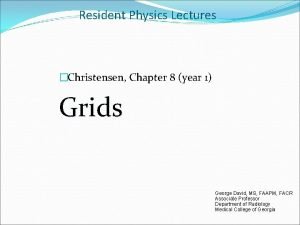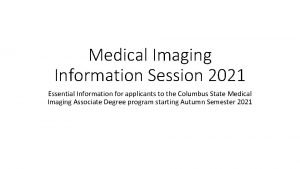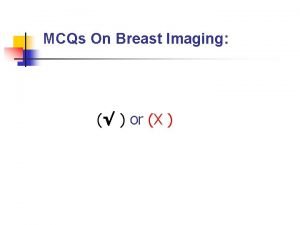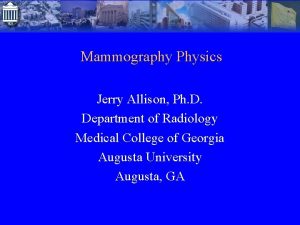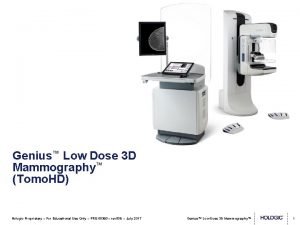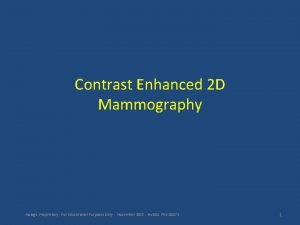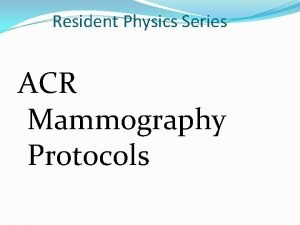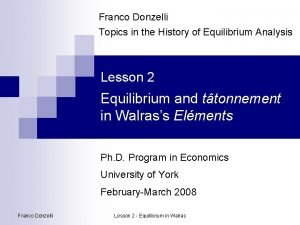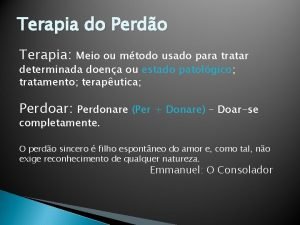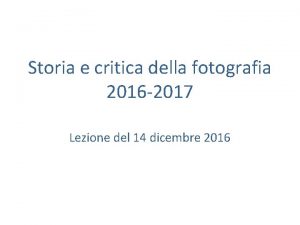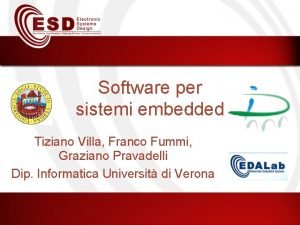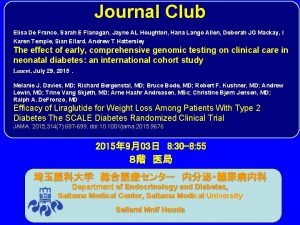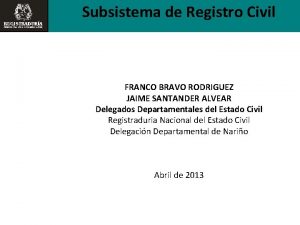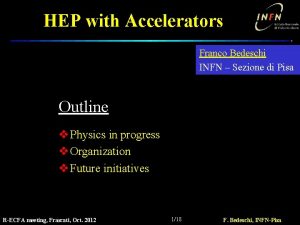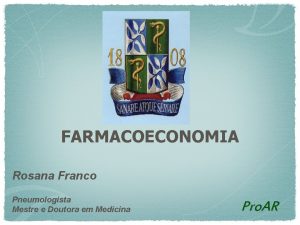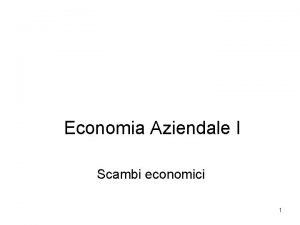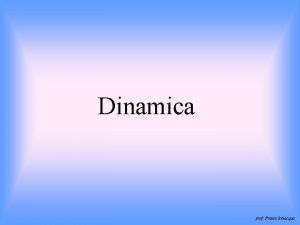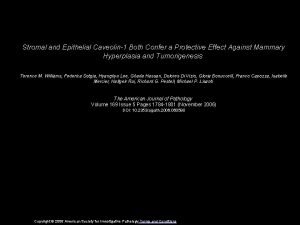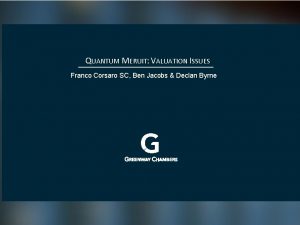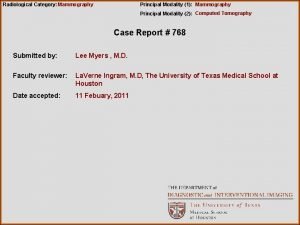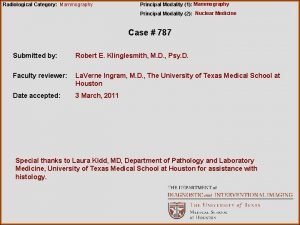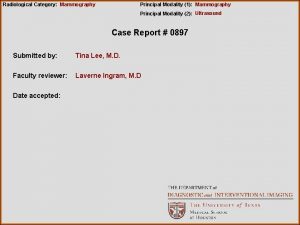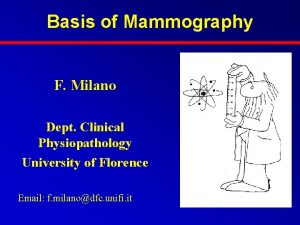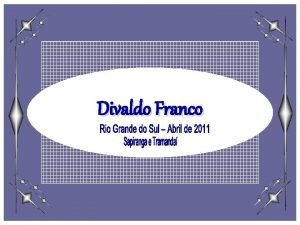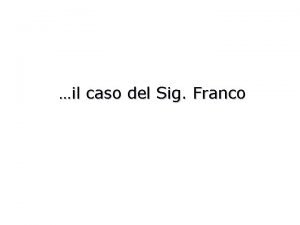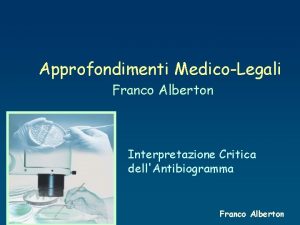QC Mammography results and digital mammography Franco Milano


























































- Slides: 58

QC Mammography results and digital mammography Franco Milano Dept. Clinical Physiopathology University of Florence Email: f. milano@dfc. unifi. it

Quality Control Programme h 27 Italian screening mammography centres h 75 mammographic units h h 18 replaced units – 21 new units Before 1995 32% – 95/96 52% - after 96 17 % h Twice per year tests h European Protocol for QC of the Technical Aspects of Mammography Screening

PERCENTAGE OF THE UNITS WITHIN THE STATED LIMITS

QC PATTERN h Light trend h Fluctuations in the results

Evaluation of the impact of a QC Programme h SUBJECTIVE EVALUATION h Trend of the mean value h Trend of the percentage values h OBJECTIVE EVALUATION h Statistical analysis

Evaluation of the impact of a QCP h Shuffling Without Replacement Method h t-Student test

Shuffling Without Replacement h Non parametric test h No hypothesis on the distribution h Randomization test h The H 0 hypothesis is that the indexes of the two sample are statistically equal h Confidence level 95%

Shuffling Without Replacement h Selection of one variable h Selection of two sample of the variable h Calculation of a statistical index h Evaluation of the difference between the two indexes h Shuffling of the two sample and extracting two new samples h Calculation of the statistical index of the two sample h Evaluation of the difference between the two index h Repetition of the shuffling step N times ( N>1000)

t-Student test h Normal distribution h Two tail test h Same H 0 hypothesis h Confidence level 95 % h Test available in the s/w package

COMPARISON OF THE STATISTICAL TEST

Evaluation of the QC Programme impact h Significance of the differences between two mean values h Reduced Standard Deviation

Test frequency h The probability of change and the impact of a change on image quality and on breast dose determine the frequencies at which the parameters should be measured (European Guidelines for Quality Assurance in Mammography Screening)

Validation of the chosen frequency for testing one parameter h In the presence of some fluctuation in the measurements of a single parameter for one unit an inadequate frequency of the test may be supposed h The Shuffling Without Replacement methods might be applied to validate a new frequency h Fluctuation within the reproducibility of the test procedure

Tube voltage accuracy 10 9 100. 00% 8 80. 00% 6 5 60. 00% 4 40. 00% 3 2 20. 00% 1 k. V >2 2 1. 9 1. 8 1. 7 1. 6 1. 5 1. 4 1. 3 1. 2 1. 1 1 0. 9 0. 8 0. 7 0. 6 0. 5 0. 4 0. 3 0. 2 . 00% 0. 1 0 0 Frequency 7

O. D. in clinical condition 12 10 100. 00% mean= 1. 42 Frequency s. d. = 0. 30 8 80. 00% 6 60. 00% 4 40. 00% 2 20. 00% 0. 5 0. 6 0. 7 0. 8 0. 9 1 1. 2 1. 3 1. 4 O. D. 1. 5 1. 6 1. 7 1. 8 1. 9 2 2. 1 2. 2 >2. 2

AEC optical density control step 35 30 100. 00% Frequency 25 80. 00% 20 60. 00% 15 40. 00% 10 5 20. 00% 0. 05 0. 15 0. 25 0. 35 O. D. 0. 45 0. 55 0. 6 >0. 6

AEC object thickness compensation 35 30 100. 00% 80. 00% 20 60. 00% 15 40. 00% 10 O. D. >1 . 00% 1 0 05 0. 15 0. 25 0. 35 0. 45 0. 55 0. 65 0. 75 0. 85 0. 95 20. 00% 0 5 0. Frequency 25

AEC tube voltage compensation 15 60. 00% 10 40. 00% 5 20. 00% 0 . 00% O. D. >1 80. 00% 1 20 05 0. 15 0. 25 0. 35 0. 45 0. 55 0. 65 0. 75 0. 85 0. 95 100. 00% 0 25 0. Frequency 30

0% 0. 5% 1. 0% 1. 5% 2. 0% 2. 5% 3. 0% 3. 5% 4. 0% 4. 5% 5. 0% 5. 5% 6. 0% 6. 5% 7. 0% 7. 5% 8. 0% 8. 5% 9. 0% 9. 5 10 %. 0 % >1 0% 0. Frequency AEC short term reproducibility 9 8 7 6 5 4 3 2 1 0 100. 00% 80. 00% 60. 00% 40. 00% 20. 00%

Spatial resolution - parallel alignment 40 35 100. 00% 30 80. 00% Frequency 25 60. 00% 20 15 40. 00% 10 20. 00% 5 . 00% 0 10 12 14 16 lp/mm 18 20

Spatial resolution - perpenducular alignment Frequency 30 25 100. 00% 20 80. 00% 15 60. 00% 10 40. 00% 5 20. 00% 0 . 00% 10 12 14 16 lp/mm 18 20

Entrance Surface Air Kerma 16 14 100. 00% 12 80. 00% Frequency 10 8 60. 00% 6 40. 00% 4 20. 00% 2 0 . 00% 4 5 6 7 8 9 10 m. Gy 11 12 13 14 >14

Mean percentage of tests within the stated limits 100. 0 95. 0 87. 9 % 90. 0 85. 7 83. 7 85. 0 80. 0 81. 2 75. 0 85. 1 83. 7 73. 9 70. 0 1 2 3 4 5 round 6 7

s. d. of tests within the stated limits 30. 0 25. 0 % 20. 0 21. 4 16. 8 16. 1 15. 0 14. 4 10. 0 12. 5 14. 0 11. 3 5. 0 0. 0 1 2 3 4 round 5 6 7

Consideration on a QC programme u A Quality Control programme is essential to assure high diagnostic quality images using as low radiations as reasonably possible u Objective evaluation methods could assess the impact of the QC procedures and indicate the suitable measurement frequency of the parameters

Digital Mammography

Why Digital Imaging? Screen-film Systems Perform Five Image Functions: h Acquire h Process h Display h Communicate h Archive

Why Digital Imaging? Digital Systems Perform the same five Image Functions and h Remove Film Variability h Minimize Retakes h Allow Contrast Adjustment To Improve Image Quality h Enable Easier Transfer Of Information h Reduce Storage Space h Permit Telemammography

Indirect Conversion X-ray 150 -250 m Light scintillation Columnar Cs. I(Tl) Pixel array Line spread function

Scintillator screen h Conversion of x-ray in visible light by Cs. I h Similar process in the film-screen system (e. g. Gd 2 O 2 S) h Reduction (partial) of scattering by string technology h Humidity dependence of Cs. I film-

Indirect detector X-ray photons X-rays Scintillator Fiberoptic taper CCD-chip

Direct Conversion X-ray Electron/hole pairs 250 m amorphous selenium TFT array Line spread function

Digital Image Receptor Direct conversion technology h h h 250 mm thick amorphous selenium photoconductor layer 70 mm TFT pixel pitch, ~100% fill factor 24 cm X 29 cm active image area X-rays IN Top electrode Charge collection electrode a-Se layer Signal Out TFT Gate pulse Charge storage capacitor

Selenium Flat-Panel Detectors

Amorphous Silicon Detector Varian

Digital Image Receptor (Direct vs. Indirect Conversion) Indirect detection degrades image sharpness h Direct detection produces a precise signal profile h Screen-Film Indirect detection Direct detection X-ray photon + + Signal Profiles

MTF impact Modulation Transfer Function (MTF) is a measurement of the contrast transfer for different spatial frequencies

Digital Image Receptor (Image Sharpness) Direct image receptor has a higher modulation transfer function (MTF) h Higher MTF = Sharper Images h Higher MTF = Superior Detail Image Contrast

Digital Image Receptor (Modulation Transfer Function) Direct detection Film screen detector CCD Indirect detection

Detective Quantum Efficiency • Detective Quantum Efficiency (DQE) –quantifies the S/N ratio of the sysstem –quantifies the contrast resolution – quantifies the dose efficency – is given as a function of the spatial frequency

Digital Image Receptor (DIR) (Dose Efficiency) DIR has high detective quantum efficiency (DQE) • Higher DQE = superior image quality • Higher DQE = reduced patient dose

Digital Image Receptor (Detective Quantum Efficiency) Direct detection Indirect detection CCD Film screen detector

Digital Image Receptor (System Comparisons) System A System B Conversion Method Indirect Detection Material Cs. I (Tl) Selenium Pixel Size TFT 100 mm CCD 40 mm CCD 27/54 mm TFT 70 mm System C System D Field of View 18 x 23 cm 19 x 25 cm 22 x 26 cm 24 x 29 cm

Digital system MTF comparison Product System A System B System C System D Conversion Method Field of View MTF at 4 Cycles/mm Direct 24 x 29 cm 0. 80 Indirect 19 x 25 cm 0. 40 Indirect 22 x 26 cm 0. 52 Direct 17 x 24 cm 0. 62

Digital Mammography Overview First Generation Second Generation †Not available for sale in the US.

A Method of Comparing Actual Detectors to a Perfect Detector — Detective Quantum Efficiency (DQE) Compare the input noise to the output noise, correcting the measured output noise for the effects of contrast and MTF which would occur with a corresponding perfect detector.

SCREEN-FILM MODEL QUANTUM NOISE Qx SWANK NOISE SCREEN STRUCTURE NOISE X-RAY ABSORPTION X-RAY TO LIGHT CONVERSION LIGHT SCATTERING h m, sm MTF(f) FILM NOISE q. L FILM RESPONSE D(q)

Incident Exposure DQE = Q 2 2 NPS OUT /( gain * MTF ) Output noise Contrast Image Blur NEQ = Q * DQE • DQE is the system radiation detection efficiency • NEQ is the effective x-ray exposure • NEQ and DQE are strongly dependent on exposure and spatial frequency!

EXPOSURE DENSITY Q = Log 10 X-ray Quantum Fluence (Q) Noise (NPS) )( ) 2 Log 10 X-ray Quantum Fluence CONTRAST MTF 2 CONTRAST ( DQE SPATIAL FREQUENCY (cycles/mm) MTF

DQE IS NOT. . . …a direct measure of CLINICAL efficacy/utility …a measure of cost-effectiveness …a number. It’s a response surface, and is a rapidly varying function of two important variables: exposure and spatial frequency …a measure of other important features (film curl, glossiness, image tone, safelight sensitivity, etc. )

What is Image Noise? • Random optical density fluctuations • Caused by a cascade of random processes • Measured by Noise Power Spectrum (NPS) • Perceived as graininess in radiographs • Limits detectability of subtle “signals”

Screen-Film Image Chain (X-rays) (OPTICAL DENSITY) Processing light screen film radiograph film noise Q NPSL NPSX Cycles/mm (X-ray NPS) INPUT X-RAY IMAGE NPSD Cycles/mm (light NPS) (NPS - Density) Density MTF 2 n (Image blur) total contrast X-ray exposure

Modulation Transfer Function is a measure of image blur. This sharpens both the signal and the incoming X-ray noise. Increasing sharpness Improved film screen system Standard film screen

Standard SCREEN-FILM SYSTEMS High-Crossover causing image blur X - R A Y S SCREEN SUPPORT PHOSPHOR EMULSION FILM BASE EMULSION SCREEN PHOSPHOR SUPPORT

IMPROVED SCREEN-FILM SYSTEMS Zero Crossover, Symmetric Film X - R A Y S SCREEN SUPPORT PHOSPHOR EMULSION ANTIHALATION FILM BASE ANTIHALATION EMULSION SCREEN PHOSPHOR SUPPORT

IMPROVED SCREEN-FILM Systems Zero Crossover, Asymmetric Film X - R A Y S SUPPORT SCREEN FILM PHOSPHOR HIGH CONTRAST EMULSION ANTIHALATION BASE ANTIHALATION WIDE LATITUDE EMULSION SCREEN PHOSPHOR SUPPORT

Comparison of DQE Surfaces Standard film screen Improved film screen system 0. 6 0. 4 0. 2 0. 0 0 Log Relative Exposure cycles/mm 1. 0 7. 0 0. 6 0. 4 D QE 0. 2 0. 0 Log Relative Exposure cycles/mm 1. 0 7. 0 Much better visibility of fine detail D Q E

Standard film screen Improved film screen system lung 0. 6 0. 4 0. 2 0. 0 Log Relative Exposure cycles/mm 2. 0 0. 3 D Q E 0. 2 0. 1 0. 0 Log Relative Exposure cycles/mm 7. 0 2. 0 7. 0 Much wider exposure latitude, much finer lung detail
 Franco-prussian war results
Franco-prussian war results Franco-prussian war results
Franco-prussian war results Lateral decentering grid
Lateral decentering grid Cscc medical imaging
Cscc medical imaging Breast anatomy mcqs
Breast anatomy mcqs Jerry allison
Jerry allison Hologic's low dose 3d mammography
Hologic's low dose 3d mammography Mammography
Mammography Self breast exam
Self breast exam Hologic contrast enhanced mammography
Hologic contrast enhanced mammography Mammo qc
Mammo qc Mqsa requirements for mammography checklist
Mqsa requirements for mammography checklist Components of mammography machine
Components of mammography machine Digital kuk result
Digital kuk result Derived grade exams
Derived grade exams Francisco franco political movement and beliefs
Francisco franco political movement and beliefs Digital market and digital goods
Digital market and digital goods Raul de mello franco junior
Raul de mello franco junior Padu franco
Padu franco Minuscola carolina
Minuscola carolina Franco banchi
Franco banchi Franco donzelli
Franco donzelli Franco donzelli
Franco donzelli Marco venier veronica franco
Marco venier veronica franco Divaldo franco bezerra de menezes
Divaldo franco bezerra de menezes Esposa de divaldo franco
Esposa de divaldo franco Terapia do perdão divaldo franco
Terapia do perdão divaldo franco Franco pinna mandrione
Franco pinna mandrione Reino franco
Reino franco Franco's fast food maths problem answer
Franco's fast food maths problem answer Generalissimo francisco franco is still dead
Generalissimo francisco franco is still dead Ivette franco
Ivette franco Tiziano villa univr
Tiziano villa univr Con esta facha de extranjero
Con esta facha de extranjero Indice de glasgou
Indice de glasgou Elisa de franco
Elisa de franco Entrevista divaldo franco
Entrevista divaldo franco Wilfredo franco laguna
Wilfredo franco laguna Sophia de mello breyner biografia
Sophia de mello breyner biografia Alvaro junqueira franco
Alvaro junqueira franco Jesus franco bravo
Jesus franco bravo Franco lucisano editore
Franco lucisano editore Zids and zods
Zids and zods Blanca ruiz franco
Blanca ruiz franco Real_meg_g
Real_meg_g Franco fatiga
Franco fatiga Franco donzelli
Franco donzelli Qué significa euro
Qué significa euro Franco gandolfo
Franco gandolfo Rosana franco pneumologista
Rosana franco pneumologista Imballaggio economia aziendale
Imballaggio economia aziendale Franco bevacqua
Franco bevacqua Renata franco
Renata franco Association franco algérienne de pneumologie
Association franco algérienne de pneumologie Franco bejarano
Franco bejarano Franco fusaro
Franco fusaro Franco capozza
Franco capozza Los reinos francos
Los reinos francos Franco corsaro sc
Franco corsaro sc


